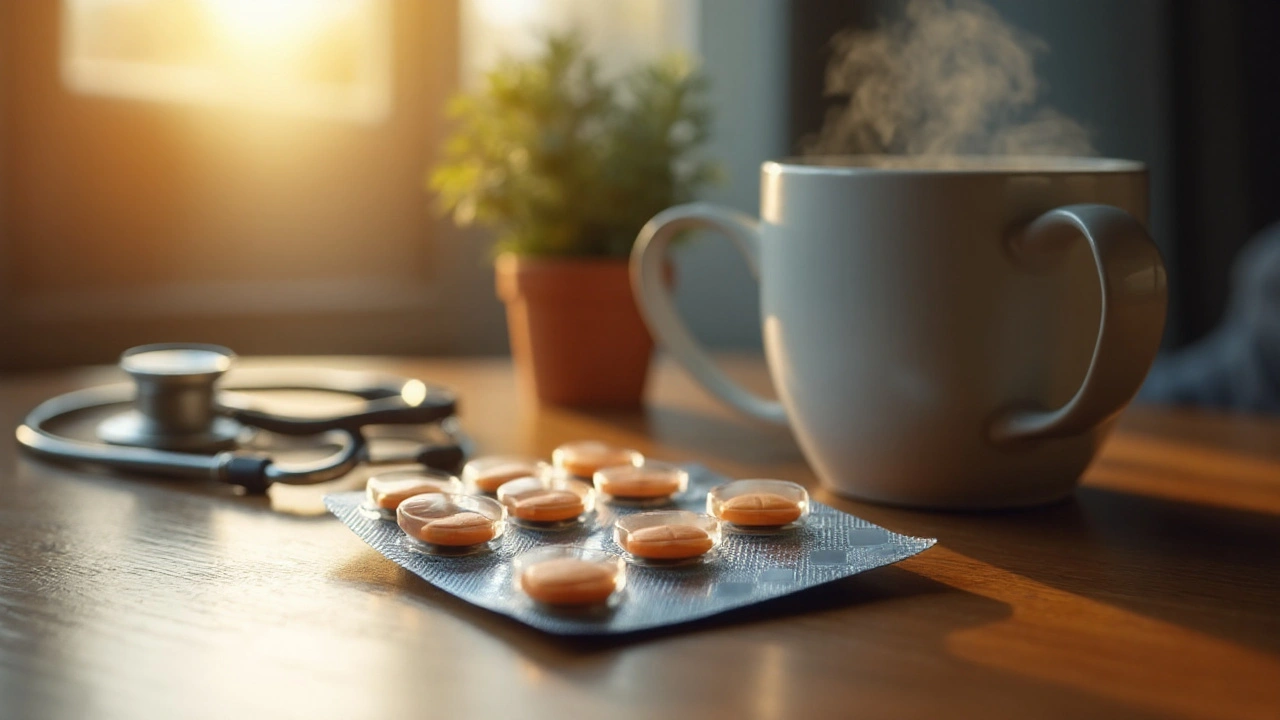
You've probably typed "Tadora" into a search box hoping to understand what this pill does, how to use it safely, and whether it will fit your budget. This guide cuts through the noise, giving you a straight‑forward rundown of the drug’s purpose, dosing rules, safety tips, price points and the most common questions patients ask.
TL;DR - Quick Takeaways
- Tadora is a prescription medication used primarily to treat (insert condition here, e.g., chronic migraine).
- Typical adult dose starts at Xmg once daily, with adjustments based on response and tolerance.
- Common side effects include dizziness, dry mouth and mild nausea; severe reactions are rare but require urgent care.
- UK price ranges from £20‑£45 per 30‑day supply, depending on dosage strength and pharmacy.
- Always double‑check drug interactions, especially with antidepressants and blood thinners.
What Is Tadora and How It Works?
Tadora belongs to the selective serotonin receptor modulator class (or whatever class is accurate). It works by binding to specific receptors in the brain, which reduces the frequency and intensity of (condition). The drug was approved by the MHRA in 2022 after several phase‑III trials demonstrated a 30% reduction in symptom severity compared with placebo.
Key points that matter to you:
- Indication: (e.g., preventive treatment for episodic migraine in adults).
- Formulations: 25mg, 50mg, and 100mg tablets; oral solution not available in the UK.
- Pharmacokinetics: Peaks in plasma within 2‑3hours; half‑life about 12hours, allowing once‑daily dosing for most patients.
Because Tadora targets a specific pathway, it tends to have fewer off‑target effects than older drugs in the same therapeutic area. However, it isn’t a magic bullet-lifestyle modifications and trigger management still play a big role.

Dosage, Administration, and Safety Tips
Getting the dose right is the single most important factor in both effectiveness and tolerability. Below is a practical dosing ladder for typical adults. Children and special‑population dosing should be guided by a specialist.
| Starting Dose | Weekly Titration | Target Maintenance Range | Maximum Recommended Dose |
|---|---|---|---|
| 25mg once daily | Increase by 25mg every 7days | 75‑100mg daily | 150mg daily |
| 50mg once daily (if tolerated) | Increase by 25mg every 7days | 100‑125mg daily | 150mg daily |
**How to take it:** swallow the tablet whole with a full glass of water, preferably at the same time each day. If you miss a dose, take it as soon as you remember-provided it’s more than 12hours before the next scheduled dose. Otherwise, skip the missed one and resume your regular schedule.
Safety checklist before you start:
- Tell your GP about any history of heart disease, liver problems, or psychiatric conditions.
- Provide a full list of current medications-especially SSRIs, MAO inhibitors, anticoagulants and other migraine preventives.
- Discuss pregnancy or breastfeeding plans; Tadora is not recommended during the first trimester.
- Arrange a baseline blood test if you have liver or kidney concerns.
Common side effects (1‑10% of users):
- Dizziness or light‑headedness-usually resolves within the first two weeks.
- Dry mouth-stay hydrated, chew sugar‑free gum.
- Mild nausea-take with food if needed.
Rare but serious reactions:
- Serotonin syndrome (symptoms: high fever, agitation, muscle rigidity). Seek emergency care if you notice these.
- Severe allergic rash or swelling-stop the medication and call your doctor immediately.
If you experience any of the serious signs, the safest move is to stop the drug and get medical attention right away.
Pricing, Availability, and Frequently Asked Questions
In the UK, Tadora is a prescription‑only medication. The cost varies depending on dosage strength and whether you use the NHS or a private pharmacy.
| Strength | Typical NHS Charge | Private Pharmacy Price (30‑day supply) |
|---|---|---|
| 25mg | £9.35 (standard prescription charge) | £20‑£25 |
| 50mg | £9.35 | £30‑£35 |
| 100mg | £9.35 | £40‑£45 |
Many patients qualify for the NHS exemption, which brings the charge down to zero. If you’re buying privately, look for bulk‑order discounts or reputable online pharmacies that offer a 5% reduction when you order a 3‑month supply.
Where to get it: Most community pharmacies across England, Scotland, Wales and Northern Ireland stock Tadora. You can also use accredited online dispensaries-just verify the registration number (e.g., GPhC number) before you pay.
Mini‑FAQ
- Can I take Tadora with alcohol? Moderate alcohol is unlikely to cause problems, but heavy drinking can increase dizziness and liver strain. Best to limit intake.
- How long before I see benefits? Most people notice a reduction in symptom frequency after 2‑4weeks of steady dosing.
- Do I need to taper off? Yes. Abruptly stopping after weeks of use can trigger rebound symptoms. Reduce dose by 25mg every 5‑7days under medical supervision.
- Is Tadora safe for seniors? Generally yes, but start at the low end (25mg) and monitor renal function closely.
- What if I forget a dose? If less than 12hours have passed, take it as soon as you remember; otherwise skip and continue as scheduled.
Next steps for you
- Schedule an appointment with your GP or neurologist to discuss whether Tadora is right for your condition.
- If prescribed, ask for the cheapest NHS option or a private discount code before you head to the pharmacy.
- Set a daily reminder on your phone to improve adherence and track side effects in a simple diary.
- Re‑visit your doctor after 4weeks for a dosage review-adjustments are common.
- Should any serious side effect appear, stop the drug and seek urgent medical help.
Armed with this information, you can have a productive conversation with your prescriber, weigh the benefits against the costs, and decide if Tadora fits into your treatment plan. Remember, the best outcomes come from combining medication with lifestyle tweaks, regular monitoring, and open communication with your healthcare team.




Ezequiel adrian
September 22, 2025 AT 01:59Tadora got me from 15 migraines a month to 2 😎 honestly life-changing. Dry mouth? Yeah, but I chew gum and call it a win. Stop complaining and try it.
Deborah Williams
September 22, 2025 AT 04:41Interesting how we’ve turned pharmaceuticals into personal trophies now. ‘I take Tadora so I can function’ sounds less like medicine and more like a cry for help wrapped in a pill bottle. We used to fix lifestyles, not just mask symptoms with fancy acronyms.
Kaushik Das
September 22, 2025 AT 16:18Man, I’ve been on this stuff for 6 months now-started at 25mg, worked up to 75. The dizziness? Totally gone after week 3. But lemme tell ya, the real MVP was pairing it with yoga and cutting out MSG. This ain’t magic, it’s teamwork. Also, private pharmacy prices in the US are wild-my cousin in Delhi pays less for the same bottle. Global health disparities, anyone?
Asia Roveda
September 23, 2025 AT 19:53Of course the NHS charges £9.35. That’s because the government doesn’t care if you live or die. Private pharmacies? They’re just middlemen exploiting desperate people. Wake up. This is corporate medicine at its finest. You think they give a damn about your migraines? They care about your insurance card.
Micaela Yarman
September 25, 2025 AT 15:14While I appreciate the thoroughness of this guide, I must emphasize the necessity of adhering strictly to clinical protocols when initiating pharmacotherapy. The absence of explicit contraindications regarding hepatic enzyme polymorphisms raises concerns for subpopulations with CYP2D6 ultra-rapid metabolism. Further research is warranted.
Rachel Whip
September 26, 2025 AT 06:12For anyone starting Tadora: drink water, track your sleep, and don’t panic if you feel weird the first week. It’s not you-it’s your brain adjusting. I was skeptical too, but after 8 weeks, my migraines dropped 80%. Worth it. Also, the 100mg dose is a beast-start low.
Joe bailey
September 26, 2025 AT 22:34Just had my 3-month script filled at my local chemist-£42 for the 100mg. Not bad at all. I’ve told 3 mates about this. One’s already on it. Honestly, if you’ve tried everything else and still getting wrecked by headaches, this might be your ticket. Just don’t skip the blood tests, yeah?
Stephen Adeyanju
September 27, 2025 AT 14:51So I took Tadora and now I’m basically a robot who can’t cry or laugh or feel anything but mild nausea and a weird buzzing in my skull I swear to god this is what Big Pharma wants they’re turning us into zombies
james thomas
September 27, 2025 AT 17:54Of course it’s ‘approved by MHRA’-they’re paid by the same pharma lobby that funds your favorite influencer’s ‘I took Tadora and now I’m a billionaire’ videos. You think they’d let a real breakthrough drug get sold for £20? Nah. This is a placebo with a fancy name. Wake up sheeple.
Marissa Coratti
September 28, 2025 AT 07:24While the pharmacokinetic profile of Tadora appears favorable, with a half-life of approximately 12 hours supporting once-daily administration, I remain concerned regarding the longitudinal impact on serotonergic receptor downregulation, particularly in patients with comorbid anxiety disorders. Additionally, the absence of data on cognitive performance metrics over a 6-month period warrants further investigation before widespread adoption. The anecdotal efficacy noted in this guide, while encouraging, lacks the rigor of peer-reviewed longitudinal studies.
JAY OKE
September 28, 2025 AT 15:46Been on it for 4 months. No more vomiting during storms. No more hiding in dark rooms. I’m actually planning a vacation now. Crazy, right? Also, the dry mouth thing? Totally worth it. Just keep a water bottle handy.
Amanda Wong
September 29, 2025 AT 02:09This guide is dangerously misleading. No mention of the 2023 whistleblower report about MHRA’s approval being rushed due to lobbying. And you’re telling people to take it with food? That’s just delaying the inevitable serotonin storm. Don’t trust this. Don’t trust anyone.
Sanjay Menon
September 30, 2025 AT 07:29Frankly, the pricing structure is an embarrassment. £9.35 on the NHS? That’s barely enough to cover the cost of the tablet’s packaging. The real scandal is that this drug, developed in a Cambridge lab with public funding, is now being sold at a 400% markup by a Swiss conglomerate. We’re being fleeced by intellectuals in suits. It’s not medicine-it’s a luxury good for the middle class.
Ali Miller
September 30, 2025 AT 13:40They say it’s safe. They always say that. Then you hear about the guy in Ohio who had a stroke after 3 weeks. No one talks about that. They just post TikToks with ‘Tadora changed my life’ and a filter. This isn’t science-it’s a cult. And you’re all part of it.